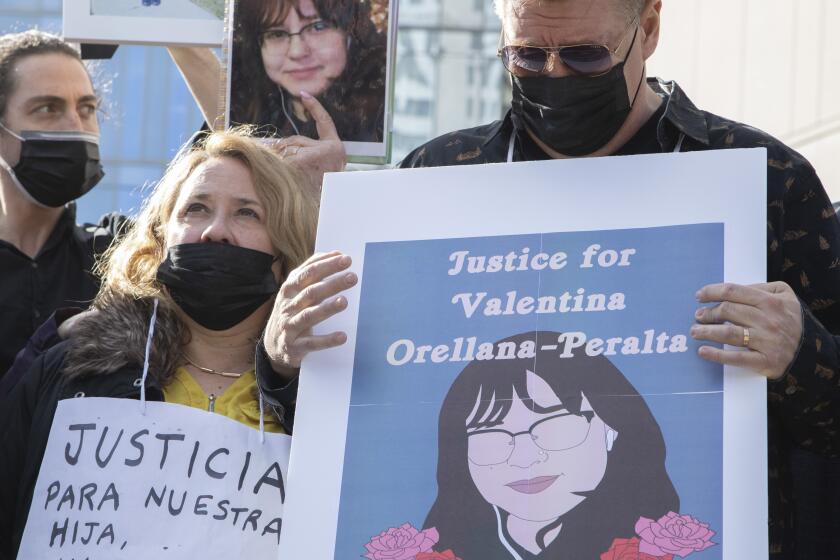The first lesson of fielding 911 calls: Don’t be alarmist

- Share via
Fourteen-year-old Valentina Orellana-Peralta was shopping with her mother two days before Christmas when she was killed by a stray bullet fired by police in the North Hollywood Burlington store. The question of why this tragedy happened falls not only on the officer’s action in that moment, but also on the information the police were given when they were sent to the store.
The officers were responding to 911 calls about a man attacking people at the North Hollywood store. Dispatch radio traffic reveals that some callers accurately reported the man was using a bicycle lock. At least one caller erroneously said he had a gun. An officer opened fire with a rifle, killing the suspect, Daniel Elena-Lopez. During the confrontation, a police round struck Valentina through a dressing room wall.
As a graduate student, I worked as a 911 call-taker in southeast Michigan to learn about how 911 calls affect policing. My field experiences and ongoing research reveal that small differences in call-taker actions can alter the entire trajectory of how police respond in these situations.
In 2018 — about a year and a half into my field work — a caller reported an in-progress break-in at his residence. He’d just returned home, which he described as a house divided into separate units, and reported seeing a 6-foot-tall Black male on the front porch. “I believe there’s a burglary in progress in my apartment,” the caller said, “and I’m just [expletive] scared.”
The LAPD tactics in the Burlington store shootings are the consequence of a government unwilling to regulate an enormous supply of firearms in the U.S.
I immediately classified the incident as a high-priority “breaking and entering” and typed the caller’s comments into the computer system. Paul, a veteran dispatcher who was working that shift, read my incident notes and downgraded my categorization to a lower-priority “suspicious circumstance” before relaying his version of events over the radio to the responding officers.
Paul then asked me several questions. Was I sure that the caller didn’t know the man? Could he have been a friend of the caller? Was it a maintenance worker? I didn’t ask the caller and I didn’t know. Those questions hadn’t crossed my mind.
Six minutes later, the police piped up on the radio to report that the suspect was, indeed, not a burglar: He was a member of a cleaning crew.
Paul’s careful classification, compared to my knee-jerk alarmist one, averted a potential disaster. Consider the arrest of Harvard professor Henry Louis Gates Jr. at his Cambridge, Mass., home in 2009. In that infamous case, the call-taker classified an ambiguous report of men struggling to open a door as a high-priority break-in. The call-taker’s characterization of the situation intensified the reaction of the responding officer — so much so that he drove the wrong way down a one-way street — and contributed to his aggressive interaction with Gates.
Paul’s intervention in my call prevented another case of the police mistaking an innocent Black man for a criminal.
In my research, I have found that some 911 call-takers simply are more alarmist than others when processing the same types of calls. All too often, whether a call is classified as high-priority depends not on the facts but on whether a Jessica or a Paul happened to answer the phone.
For example, I found that officers responding to a dispatch about a potential high-priority suicide are six times more likely to deem the incident as such at the scene, than if a different call-taker had selected a lower-priority categorization. Likewise, those responding to a dispatch about a potential high-priority assault are two times more likely to characterize the incident in that way than if they heard a less alarmist dispatch. These differences are the result of varying initial classifications made by the call-taker, not due to differences in actual incident severity.
The Rev. Al Sharpton will deliver the eulogy for Valentina Orellana Peralta, who was killed when an LAPD officer opened fire on a nearby assault suspect.
Some call-takers are so concerned with maximizing responses that they discount the risks that come from hyping up the situation to the police. This can be tremendously dangerous. Research has shown that in controlled experiments, when officers were incorrectly primed by dispatch, that contributed to a significant increase in officers choosing deadly force.
There are several reforms that municipal leaders and police officials, who oversee emergency communications centers, can make to rein in alarmist call-takers to avoid harmful policing.
First, dispatch centers must help dispatchers to broaden their mindset when it comes to risk. Call-takers who are risk-averse may fear generating an under-response from responders. But they should be aware of the great risk an over-response can carry. I was an alarmist, in part, because my training emphasized that it’s better first to send a high-priority response and dial it down if need be, rather than ratchet it up later. But this thinking fails to appreciate the harms that arise from priming police for high-intensity encounters.
Second, dispatch centers should monitor call-taker practices and provide more training opportunities and feedback to improve their practices. Call-takers rarely learn the outcomes of calls, and more information about that could also help.
It’s too early to know how the interpretative choices the 911 call-takers made from the conflicting information they received may have affected the LAPD response at the Burlington store. But any future incident review should consider them.
Jessica Gillooly is an assistant professor of sociology and criminal justice at Suffolk University. She also is a 911 subject-matter expert for the Policing Project at NYU School of Law.
More to Read
A cure for the common opinion
Get thought-provoking perspectives with our weekly newsletter.
You may occasionally receive promotional content from the Los Angeles Times.










